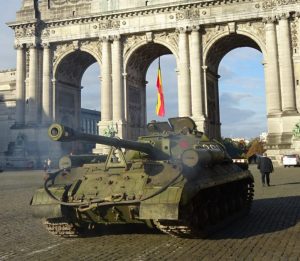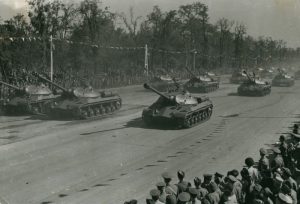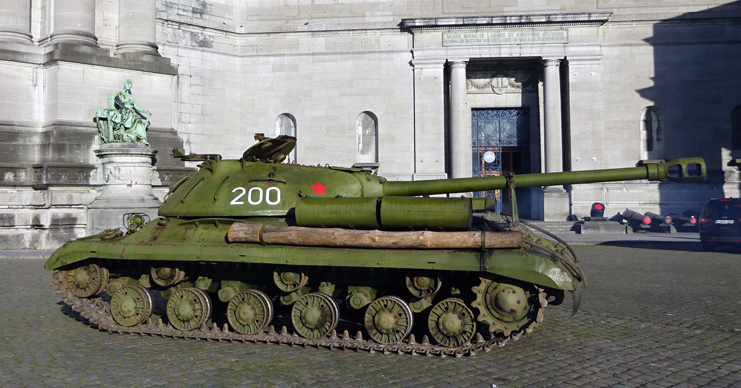TANKFEST 2018, to be held at The Tank Museum, UK, June 29 – July 1, will feature a running IS-3M Heavy Tank, appearing in the United Kingdom for the first time. The Belgian Royal Military Museum in Brussels has kindly lent it to The Tank Museum for the event.
Despite the best efforts of the Soviets, the IS-3 was not ready in time to see action in WWII. When it was unveiled at the Allied Victory Parade, in 1945, its advanced design shocked their Western allies.

The IS-3
Both used the same Kharkiv V2-IS diesel engine and had similar automotive arrangements. They also mounted the same 122mm D-25T gun. Adapted from an in-service artillery piece, it very convincingly resolved the KV-1’s problem of inadequate firepower. Its armor piercing rounds could penetrate the frontal armor of a Tiger at 1,800 meters – over a mile.
The IS-3 carried 28 rounds, generally split between 18 HE-Frag and 10 AP. The projectile and charge were loaded separately, which doubled the workload and restricted the rate of fire to two or three rounds per minute. The job was made more difficult by the highly sloped turret sides, which limited space to work in. The four-man crew consisted of a commander, gunner, loader, and driver.
The new tank’s armor was far thicker than the IS-2, but the redesigned layout meant the IS-3, at 46 tonnes, weighed only around 1 tonne more. The ‘pike nosed’ hull front was up to 120mm thick and the turret front a maximum of 240mm. The extreme sloping increased the effective thickness still further and rendered the IS-3 virtually impervious to any German gun at realistic combat range.
The combination of protection and firepower meant the IS-3 was in high demand and production was rushed. Unfortunately, it resulted in several mechanical issues being left unresolved. By May 24, 1945, twenty-nine had been built at Kirovsky, but only seventeen had passed testing. Production ended in mid-1946 after 2,311 had been made – just under half the number of IS-2s.
Between 1948 and 1952 extensive remedial work was carried out. It included reinforcing the engine mounting brackets and hull roof, improving the clutch and gearbox, and replacing the radio.
Many flaws remained, however, so more work was carried out in the mid-1950s (resulting in the IS-3M designation). The most prominent improvements were structural reinforcements to the hull and replacing the engine. They significantly improved the tank’s reliability, but by that stage, it was clear the IS-3M’s days were numbered. Most were put straight into mothballs.
More reliable than its successor, the IS-2 also received upgrades. In fact, the resulting IS-2M outlasted the IS-3, last being used in exercises in 1982.
Service History

Despite the Soviet efforts, the IS-3 arrived too late to see service during WWII. It was first seen in public at the Allied Victory Parade in Berlin on September 7, 1945, when the advanced design of the new tank astonished the Soviet’s Western allies.
The IS-3 saw minimal combat service. The Soviets only ever used it during the Hungarian Uprising in 1956. On October 23 Hungarians began protesting against their Soviet-controlled government. The protests escalated into street fighting, and Soviet armored units sent into the city suffered losses to fighters armed with grenades and Molotov cocktails. Fierce fighting continued until November 11, costing the lives of 2,500 Hungarian soldiers and civilians and 700 Soviet soldiers. According to Soviet records, just one IS-3 was damaged beyond repair.
The Egyptians also made use of the IS-3M. They possessed around 100 from 1956 onwards which saw combat against the Israelis during the Six Day War of 1967. Its thick armor and massive firepower worried the Israelis, but the outdated systems on the tank and inadequate training and motivation of the Egyptian crews meant they were not deployed to their full potential. The Egyptians lost 73, with many simply being abandoned. Captured in full working order by the Israelis they were re-engined with the powerpack from the T-54 and utilized until the early 1970s.
This Vehicle
Unfortunately, the service history of the IS-3M running at TANKFEST is unknown. It was donated to the Belgian Royal Military Museum in 1989, along with an ISU-152 assault gun.
After many years on display in the Museum’s tank courtyard, in 2010 the vehicles were moved to the Museum’s Bastogne Barracks site for restoration. In 2016 the IS-3M took part in the 60th Anniversary commemoration of the Hungarian Uprising and traveled to Soesterberg in the Netherlands for the Dutch National Military Museum’s TankEvent.
See the IS-3 running at TANKFEST 2018, June 29 – July 1. Tickets are available here.
The photographs in this article are reproduced by kind permission of Pascal Mathieu and the Belgian War Heritage Institute (www.warhistory.be).
A message from The Tank Museum:
“Please Support Us: As a charity, we rely on public support for all our activities. Our work is funded entirely by people like you. With your support, we can continue to create content. With the right support we might be able to do it more regularly – and can be even more ambitious. Please Click on the Banner Below.”

